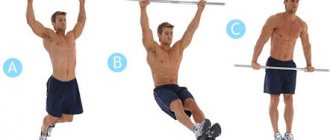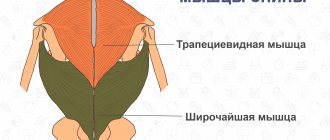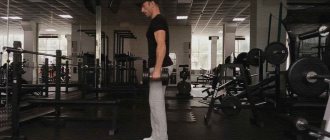Back pain today is experienced not only by older people, but also by quite young people. There are two reasons for such sensations - the consequences of serious illnesses and insufficient muscle strength of the spine. The first pain requires special medical treatment; patients should consult a doctor. But you can and should prevent or get rid of pain arising from weak muscles on your own.
Warm-up for the back
Why is it important to strengthen your back?
The back muscles consist of two muscle groups:
- Wide . They are tied at the bottom of the spine, higher diagonally they cover the entire back. At the top, the athletic back looks like wings; the silhouette of a person with developed muscles resembles a triangle with the top down. The lower part of the muscle encircles the waist.
- Trapezoidal . They encircle the base of the skull, then hold the neck and move the shoulders.
Back muscles
Muscles and ligaments are fixed to the segments of the spine and are responsible for bends and inclinations. But their main task is to relieve stress from the spinal discs and maintain the body in a physiologically correct position.
Side and front view of the lumbar spine
If the back muscles are very weak, then certain parts of the spine bend unnaturally, the intervertebral discs are strongly pressed against each other, become thin and lose elasticity. As a result, the joints are not lubricated, and due to increased friction, accelerated wear occurs. The bones begin to irritate the nerve endings, and this leads to back pain of varying intensity and duration. Warm-up and training of the spinal muscles prevents degenerative changes in tissues and significantly improves the quality of life for many years. Regular exercises make it possible in many cases to completely restore the normal condition of the back.
Back exercises
If the back is weak, then this significantly complicates the course of acquired spinal pathology. A sedentary lifestyle, a critical lack of physical activity, and excess weight are a big problem for modern people. Warming up for the back is one of the means to eliminate or prevent unpleasant sensations.
Prices for mats for yoga and fitness
Why do you need a warm-up for your back?
It is recommended to warm up your back in two cases: before intense sports training and in everyday life before heavy physical work or after a long stay in one position. If you do not warm up and immediately heavily load the muscles, then there is a high risk of various stretch marks and more complex ruptures of muscle tissue. After warming up, muscle elasticity improves, blood circulation in tissues increases, the nervous system is activated and prepared for heavy loads.
Back workout at work
The duration of the warm-up is approximately 10 minutes, the effectiveness and intensity is assessed by the dynamics of pulse changes. Depending on the type of exercise, back warm-up can be of several types.
Table. Types of warm-up for the back.
| Type of warm-up | Short description |
| Dynamic | The desired position is taken - this is the starting position. From the chosen pose you need to reach various points; they can be located below, above or horizontally. You should stretch until you clearly feel a stretch in the muscle fibers. After this, the body returns to its original position, the muscles relax. |
| Static | This warm-up consists of ordinary stretching exercises. You need to stretch to the point at which you feel a slight tension in a certain group of spinal muscles. Next, you should linger for a few seconds, and only then return to the starting position. This warm-up is recommended for beginners; it is safer and does not create greater stress on the cardiovascular system. Allows you to gradually prepare the body for increasing muscle loads after warming up. |
Simultaneously with warming up the back, it is recommended to do a massage; targeted warming of the muscles additionally prepares them for the upcoming loads.
Massage roller
Warm-up structure
Warm-up before strength training should consist of three components:
- Joint warm-up. It involves performing as wide a range of motion as possible in all joints. Due to this, the body warms up.
- Warm up before performing a specific exercise. It involves performing an exercise with minimal weight. For example, before a bench press, perform a high-repetition set of bench presses with an empty bar.
- Warm up between sets. It includes additional warm-up of the target muscle group between sets.
Let's look at each part of the warm-up in more detail.
Multi-joint warm-up
A multi-joint warm-up is carried out from the top of the body to the bottom and takes about 5 minutes until you feel that all joints and ligaments have been warmed up. All rotations are performed both in one direction and in the other. The greater the amplitude of rotation, the more effective the warm-up will be.
The peculiarity of performing my version of a multi-joint warm-up is that it is performed in conditions of constant jumping on the toes. The movements begin with rotation of the neck, shoulder girdle, then with the elbow joints and movements of the hands. Without jumping, circular rotations of the body are performed with a stationary pelvis to warm up the lower back. After this, we put our feet together, our hands on our belts and rotate the hip joint. Then, placing your hands in front of your chest, rotate your body left and right, stretching your back.
At the next stage, we warm up each leg in turn: we lift one leg, bend it at the knee and begin to rotate it, describing a circle in the air with our feet. Then warm up the ankle: rest the toe of the foot on the floor and rotate the leg. After this, we perform rotations with each leg alternately in the hip joint. In addition to these movements, perform 10-15 squats at a smooth pace to parallel level, and then 10-15 squats below parallel. Then we perform crunches while lying down, doing 10-20 repetitions.
During the warm-up, it is important to perform an exercise on the rectus abdominis muscle (abs), since there are many capillaries in this area, and with these movements we accelerate the blood throughout the upper body, warming up all the joints.
Bodyweight exercises performed at a slow pace activate the motor centers in the nervous system and prepare the musculoskeletal system for strength work. For example, if you're doing a bench press, do 2-4 rounds of ten gentle push-ups, 10 squats, 5 pull-ups, and 20 bench crunches. The blood will slowly spread throughout the body, and the shoulder girdle will get a warm-up. Do two or three circles at a slow pace, and do the last circle at an accelerated pace to prepare the nervous system for work.
Experiment with exercises and observe how you feel. Use in your workouts exactly the warm-up option that best prepares you for strength training.
Warm up before performing a specific exercise
This warm-up consists of performing warm-up sets with light weights. The number of such approaches can vary from 4-5 to 8-10, and you should start with an empty bar, gradually adding weight and practicing the correct technique for performing the exercise. Having reached the “working” weight, perform 1-2 more approaches with this weight, and only after that proceed to the main part of the strength training.
Warm up between sets
After you have already started performing the main part of the workout, to further warm up a specific muscle group working, you can warm it up between sets with rotations and movements in the corresponding joints.
To warm up, choose suitable clothing: you should be warm. Wear additional equipment if necessary. By the end of the warm-up, your body should be well warmed up and, accordingly, ready for the upcoming load. It is necessary to strictly follow the main rules of warm-up, namely, perform exercises with your own weight at a slow pace, practice the technique with an empty bar and minimal weights. This is a prerequisite for progress.
Very often, athletes with little training experience experience insufficient joint mobility and muscle elasticity. In such cases, it is necessary to spend additional time on quality stretching after training.
Back exercises
The complex is developed by professional instructors and sports doctors, taking into account the upcoming loads and physiological characteristics of muscle groups. Be sure to include static and dynamic exercises, which increase the elasticity of the ligaments and the mobility of the spine. The warm-up complex can be used by people with insufficient physical development parameters instead of strength ones. The latter are still difficult for them to do, and increasing the number of warm-up exercises allows them to gradually return the muscles to the desired state.
Warm-up for the neck and back, exercises
To increase the effectiveness of the exercises, it is recommended to perform 2-4 times a week with a gradual increase in intensity. To reduce the body’s fatigue, exercises are specially alternated; after straining exercises, relaxing ones are performed. Due to this approach, the possibility of overloading the cardiovascular system is eliminated, the muscles have time to fully rest and be enriched with oxygen. The correct choice of an individual complex does not allow spasm of the muscles of the back and neck. If it is not possible to seek advice from professional trainers, then adjust the load yourself. You should always be guided by one rule - warming up should not cause discomfort, exercises should be done with average effort. This is the number of approaches during training and the magnitude of the loads is selected according to the maximum capabilities, training requires a lot of effort, some exercises are performed despite the body being very tired. The purpose of the warm-up is to improve blood circulation, speed up metabolism, stimulate nerve endings, and improve the tone of the nervous system. And, as a result, prepare the body for significant physical activity. An effective warm-up can be done with the help of such exercises.
Warm up before exercise
boat
An exercise accessible to everyone, it perfectly warms up not only the muscles of the back, but also the lower back. By strengthening muscles, the following results can be achieved:
- correct posture is formed:
- the corset muscles are strengthened;
- the mobility of the vertebrae and pelvic joints increases;
- Physiological nerve impulses are restored, blood supply to internal organs is improved.
Exercise "Boat" for the back
The exercise is part of a mandatory complex of therapeutic exercises to correct spinal curvatures; in addition, it will help you lose excess weight around the waist.
The boat is performed in two positions: lying on your back and lying on your stomach. You can choose any, but experts recommend alternation.
"Boat in a Storm"
Boat on the stomach
- Take the starting position, stomach on the mat, take a comfortable position.
- Straighten your limbs as much as possible, tense your spinal muscles.
- Bend over, while straining the muscles of your limbs. Hold for a few seconds, as the muscles strengthen, the time gradually increases.
"Boat" on the stomach
Boat on the back
It is easier to perform; it is recommended to increase the number of approaches.
- Lie on your back, arms along your body, legs pressed tightly together.
- Raise your legs approximately 20–25 cm from the horizontal surface, raise your torso, and bend your arms at the elbows.
- Stay in this position. If fatigue appears, gradually straighten up.
- Lie down in the starting position, relax all muscles.
The general rule for warming up is that there should not be severe fatigue; after each exercise, you should give the muscles time to fully rest. You should feel a pleasant warmth in your muscle tissues.
Lateral version of the exercise
Cat
This exercise, unlike the first, is not aimed at tensing the muscles, but at stretching them. All exercises for warming up the back are alternated in the same way. At the same time, the muscles of the spine and abdomen are strengthened, the back becomes more flexible, and the mobility of the vertebrae is restored. This warm-up makes it possible to get rid of back pain and is great for pregnant women.
Exercise "Cat"
If you do it regularly, your posture will be corrected, your body's endurance will increase, and your internal organs will function better. The exercise has several varieties.
Classic cat
Can be done both in the morning and in the evening after the end of the working day.
- Slowly lower yourself to your knees on the floor, support yourself with your hands, and stretch your back as much as possible.
- As you inhale, bend your back in an arc, stretch your vertebrae. Stay in this position until you feel tired.
- As you exhale, return to your original state.
Classic "Cat"
Don't overwork yourself, remember that you are stretching your back, not pumping your muscles.
"Sphinx"
If you want to know a detailed description of exercises to exercise your back and spine, you can read an article about it on our portal.
Japanese cat
It differs from the usual one in that in the initial position the legs are not together, but apart. Due to this, the muscles and ligaments of the pelvis are developed, which is very useful for pregnant women. The hands rest not on the palms, but on the elbows. Further movements are identical to those described above.
Japanese "Cat"
The cat moves its tail
The starting position is like in a classic cat. The difference is that only the pelvis moves in a circular manner. First, a few turns clockwise, and then counterclockwise.
This exercise is slightly different from the classic version.
All types of this warm-up exercise should be performed without excessive loads, and you should constantly monitor your well-being. Movements should be done smoothly, without jerking or unnecessary stress. If there is an assistant, it is advisable that he maintain the position of the back at the points of maximum bending. Due to this, back mobility improves in the initial stages of physical training.
Crocodile
It is better to do the warm-up immediately after waking up, you can do it right on the bed. In the morning, the body requires a general warm-up; it is recommended to start from the back. Breathing should be calm and deep, movement should be slow, without significant effort. Based on this exercise, Dr. Antipko created a complex that improves the condition of the spine. It should be done only for medicinal purposes; it is not suitable for warming up.
Exercise "Crocodile" for spinal health
- You need to lie on your back, feet approximately shoulder-width apart, spread your arms to the sides, with your palms facing up.
- At the same time, the head slowly turns to the left and the pelvis to the right. The right thigh should take a horizontal position. If this is difficult to do at first, there is no need to make excessive painful efforts; after a few days, the mobility of the spine will be restored to physiological levels. Moreover, such favorable changes occur regardless of age.
- Slowly return to the starting position, rest a little, and restore the rhythm of your breathing.
- Repeat the exercise, only the movements should be in the opposite direction.
Exercise "Crocodile"
Select the number of turns depending on your well-being and initial physical capabilities.
Knee pull-up
Not only the muscles on the back, but also on the stomach are excellent for warming up.
- Starting position - lying on your back, arms extended behind your head, legs straight, body completely relaxed.
- As you exhale, bend your legs at the knees, pull them to your chest, clasp them with your arms and lift them as far as possible from the floor level. But without excessive tension, you cannot achieve the desired result the first time. We must remember that haste can cause serious injuries; the back does not like strength experiments.
- As you inhale, return to the starting position.
Pulling your knees to your stomach
Step by step guide
Warm-up includes exercises for the lower back, thoracic region and neck.
Warm up the cervical, thoracic region and lower back, if they hurt, you can twist the torso:
- Take the starting position, lying on your back, bend your legs at the knee joints, stretch your arms to your sides.
- As you inhale, tilt your lower limbs to the right and left alternately, trying to touch the support, while the body should turn in the opposite direction.
- Hold at the maximum points for several seconds, and while exhaling, return to the starting position.
- Repeat the exercise up to 10 times in each direction.
For lumbar osteochondrosis, the “cat” stretch will be beneficial:
- Take a position on all fours, legs and arms should be at shoulder level.
- As you inhale, bend your lower back down and hold this position for several seconds.
- As you inhale, round your back as much as possible, lower your head, and hold for a few seconds.
- Repeat the exercise up to 10 times.
You need to stretch your neck slowly and carefully.
A back extension exercise that is good and quick to stretch your back is an analogue of hyperextension, which together strengthens muscle structures and stretches the spine.
- Take a position lying on your stomach, rest your hands on the floor at chest level.
- As you exhale, straighten your arms, arching your back and throwing your head back.
- Hold at the maximum point for several seconds and return to the starting position.
- Repeat the movement 7-10 times.
The neck, shoulders, shoulder blades, lower back and sacrum can be warmed up by performing the fetal position exercise:
- In the starting position, lying on your back, clasp your knees with your hands, pulling them to your chest.
- Try to move forward, trying to take a sitting position, with your head tilted forward.
- Perform until tension is felt in the back.
The “bridge” exercise is effective. You can use a gymnastic fitball, on which you lie with your back and perform smooth rolls back and forth.
Rows on the horizontal bar are good for stretching the spine and surrounding muscle structures, especially if you have done deadlifts before. The duration of the hang is 25-40 seconds. It is not recommended to jump off the bar to avoid straining your muscles.
To relieve muscle spasm
When working sedentarily, it is recommended to do a light warm-up every hour.
If your back begins to hurt at the top or bottom due to muscle spasm, you can relax the section by doing the following exercises:
- from breathing exercises: while inhaling, strain your back, while exhaling, relax your back;
- with extreme tension: try to strain the painful area of the back as much as possible, and maintain this state for 20-30 seconds.
If your job requires you to sit most of the day, for example, in an office position, massage of the cramped area will be effective. Kneading, rubbing, deep pressure, and vibration movements are carried out. Stretching is alternated with isometric exercises. You can increase the effectiveness of massage by performing yoga asanas in combination.
Massage using ice is not inferior in effectiveness to manual technique. Rub the spasmodic area with a piece of frozen water in a circular motion. This allows you to remove pain and tension in the first minutes of the massage, as well as activate blood flow.
Practical tips for warming up
In severe stages of osteochondrosis, do not do certain movements; only the attending physician can adjust the load and types of exercises. As soon as the acute pain disappears, it is recommended to first give a light massage of the spine. One rule must be remembered - you can perform the entire warm-up complex only after the lower back pain has completely disappeared. What movements should be done with extreme caution?
- Bend down from a standing position. This exercise displaces the vertebrae as much as possible; you need to constantly monitor your well-being.
- Bends to the sides without hand support. There is no need to overload the muscles of the lumbar girdle.
- All movements with weights. Weights are recommended to be used only by trained and well-developed people or professional athletes.
Bends must be done with caution
Warm up before training. Set of exercises: video
Warming up the muscles and joints before training is the main and most important function of warming up!
The benefits of warming up
- Increased body temperature.
- Improving the mobility of muscles and joints and their activation. The correct technique of movements is prepared.
By raising your body temperature, you soften the tissue around your joints, increasing their range of motion. Increased flexibility does two things: it allows your body to move better during workouts and it helps protect you from injury.
Improving your mobility will help reduce your risk of injury and will help your body use the right muscles for certain movements and prepare them for an effective workout.
The technical component is to first prepare the body for complex movements at a basic level. For example, you could warm up by doing squats to prepare your body for squat jumps later in the workout itself.
So what can you do about the lack of time? The truth is, you only need five minutes to do a light warm-up before your workout. You just need to stop looking at it as a distraction from your training. It's better to recognize that warming up helps you maximize the effectiveness of the minimal time you have.
A good pre-exercise warm-up should match the range of motion required for the specific workout. So if you're going to do an upper body workout, you might want to spend more time warming up your shoulders and thoracic spine (upper back) and less time doing exercises to warm up your glutes and legs. In contrast, if you're going to be running or doing sprint intervals, you can better stretch your hips and ankles and warm up your glutes with your hips and knees.
There are many exercises you can do before your workout. The article provides a warm-up complex that can be used for 5 minutes. This program is a good warm-up for most strength training sessions. Every muscle will not be left unattended.
Pre-workout muscle warm-up routine
| Exercises | Sets | Repetitions/Time |
| 8 hip internal rotations, 8 external hip rotations | 1 | 8 |
| 8 circles with arms forward, 8 circles with arms back | 1 | 8 |
| 2 minutes jumping rope | 1 | 2 minutes |
| 8 rack outlets for strip | 1 | 8 |
| 12 deep reverse lunges with knee raises | 1 | 12 |
| 15 squats plus 10 reps with momentum at the end | 1 | 15+10 |
Physical education - clinics in
Choose among the best clinics based on reviews and the best price and make an appointment
Family
Scoliosis Treatment Center named after K. Schroth
Moscow, st.
Azovskaya, 24, building 2 POM VI/KOM 5,6,7/ET 1 Sevastopolskaya
+7
- Consultation from 1500
- Exercise therapy from 2700
0 Write your review
Family
Medical
Moscow, st.
Arbat, 28/1 building 1 Smolenskaya
+7(495)212-90-98
- Reception from 700
- Neurology from 700
- Physiotherapy from 155
10 Write your review
Family
Medical
Moscow, Maroseyka, 10/1, building 3
Kitay-Gorod
+7
- Reception from 7500
- Manual therapy from 2000
- Massage from 2000
9 Write your review
Show all Moscow clinics
Physical education - specialists in Moscow
Choose among the best specialists based on reviews and the best price and make an appointment Warning
: Illegal offset type in isset or empty in
/var/www/spina-expert.ru/data/www/spina-expert.ru/wp-includes/taxonomy. php
on line
290
Zakrevskaya Natalya Alekseevna
Moscow, 1st Lyusinovsky Lane, 3 B. (Medical) +7
0 Write your review
Warning
: Illegal offset type in isset or empty in
/var/www/spina-expert.ru/data/www/spina-expert.ru/wp-includes/taxonomy.php
on line
290
Avtandilyan Arsen Alikovich
Moscow, Landyshevaya st., 14, bldg. 1 (Medical)
+7
0 Write your review
Warning
: Illegal offset type in isset or empty in
/var/www/spina-expert.ru/data/www/spina-expert.ru/wp-includes/taxonomy.php
on line
290











